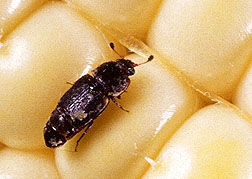This page has been archived and is being provided for reference purposes only. The page is no longer being updated, and therefore, links on the page may be invalid.
Villain Insect Enlisted for Good DeedsBy Ben HardinJanuary 19, 2000 Blossoms of sugar apple and atemoya have long attracted pollinating sap beetles. The problem is, neither these insects nor others seem to have worked hard enough at their pollination duties. To produce these unusual and tasty fruits for consumers, commercial orchardists resort to hand-pollination. A solution: Give the beetles a whiff of chemical attractants and yeasty-smelling bread dough. Agricultural Research Service scientists at the National Center for Agricultural Utilization Research, Peoria, Ill., first discovered and synthesized the attractants, called pheromones, that worked well in experiments to monitor and control sap beetles in crops where they are pests. Then, to coax sap beetles to better perform their “good guy” pollination role, University of Florida and ARS scientists loaded pheromones and bread dough into bait stations in flowering sugar apple and atemoya trees. Stymied by screens keeping them out of the stations, the beetles moved on to pollinate blossoms. Atemoya and sugar apple, tropical relatives of the Midwestern native paw paw, are noted for their delicate mango- and vanilla-like flavor and custard-like pulp. The fruits are often eaten from the “shell,” cut into pieces for fruit cups or salads or blended and frozen with citrus juices. In the two-year study, pheromone bait stations increased by many times the number of flowers that began to develop and set fruit--a sign of improved pollination. However, stresses kept many of the extra fruits from developing fully. Now, improved growing practices that lessen failed fruit development are helping increase production. The sap beetles—Carpophilus or nitidulid species—that pollinate the trees also sometimes inflict serious damage on many of the world’s other “minor” fruit crops. For example, in some years, nitidulids have caused $2.5 million in damage to the California fig crop alone. ARS is the U.S. Department of Agriculture’s chief scientific research agency. Scientific contact: Robert J. Bartelt, ARS National Center for Agricultural Utilization Researchh, Peoria, Ill., phone (309)681-6237, bartelrj@mail.ncaur.usda.gov. |

